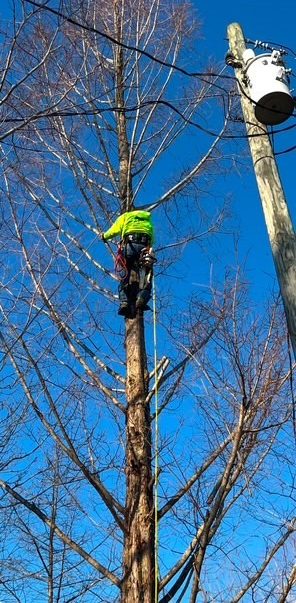Tree Trimming
Our goal is to keep trees healthy while making sure they do not interfere with electrical equipment. The amount of tree trimming depends on several factors:
- Tree species
- The voltage of surrounding power lines
- The proximity of tree branches to power lines
WHY IS TREE TRIMMING/REMOVAL NECESSARY?
MPUA trims trees near power lines on a periodic basis to maintain the reliability of your electric service and reduce outages. With safety at the heart of MPUA’s mission, maintaining the proper clearance between electrical lines and trees also increases the safety of the public. Open and visible power lines help protect our workers, contractors, and the public working near these lines by avoiding accidental contact. High winds, ice, and decay are a few of the causes that can lead to fallen limbs which may damage power lines and result in long outages while repairs are made. In the event that repairs to electric lines are necessary, having visible lines help to expedite this work and shorten the length of time your power may be interrupted.
CAN MPUA LEGALLY TRIM TREES?
Yes. The purpose of tree trimming is to maintain a safe and reliable electric system and reduce tree-related outages. MPUA has the right and the obligation to our customers to maintain any and all vegetation within its easements for these purposes. The court and legal system strongly support utilities’ rights to trim and remove trees or brush within and outside easements or Rights-of-Ways for this purpose.
The Schedule of Rules and Regulations, which are an essential component of the TVA-approved rate schedule for MPUA, states that MPUA shall have access to customers’ premises for the purpose of maintaining any or all equipment belonging to MPUA, which includes tree trimming activities.
WHAT METHOD OF TRIMMING DOES MPUA USE?
MPUA utilizes the lateral pruning method developed by the International Society of Arboriculture and recommended by the Arbor Day Foundation. Lateral (directional) trimming involves cutting branches back to the trunk or major limbs. This minimizes re-growth in the direction of the electric lines, thus requiring less trimming to the tree in subsequent years. The size of the branches cut in lateral trimming may be larger than those common with topping or rounding, but fewer cuts minimize the tree’s susceptibility to decay, disease, and insects. Initially, the appearance may seem drastically different, but in most cases, a few months of re-growth improves the appearance.
WHAT ABOUT STORM DAMAGE?
Regardless of how aggressive a utility’s tree trimming program may be, storm damage related to trees and limbs will still occur. MPUA will clear storm-damaged trees from our electric lines to restore service or allow reasonable access for emergency service restoration. The clean-up of storm debris removed from MPU’s lines and facilities during a storm or to provide emergency access will be the responsibility of the owner of the tree(s).
WILL MPUA REMOVE TREES IF NECESSARY?
Yes, if there are trees growing underneath or too close to the high-voltage primary electric lines that cannot be properly trimmed to maintain an acceptable appearance. In other cases, there are trees that may be decaying, dying, or storm-damaged that have a high probability of falling onto high voltage electric lines or other critical components of the electric distribution system. In these cases, MPUA will remove the tree in question. MPUA will not remove trees that threaten service lines that connect to a home or building but will make arrangements to remove any MPUA-owned lines connected to the house or building so the owner may remove the tree himself. There is no charge for this service during MPUA’s regular work hours.
WHAT ARE THE PROPER CLEARANCES?
In general, MPUA will strive to obtain a minimum of 10′ clearance from our 13,000-volt lines when trimming trees to allow 3 to 4 years of growth before it becomes necessary to trim again. Some faster-growing species may require more initial clearance in order to extend the trim cycle. Limbs may be cut further from the lines to comply with lateral pruning methods. Overhanging limbs will be cut as high as possible above the lines, and every effort made to remove weak, diseased, or dead limbs above the lines.

